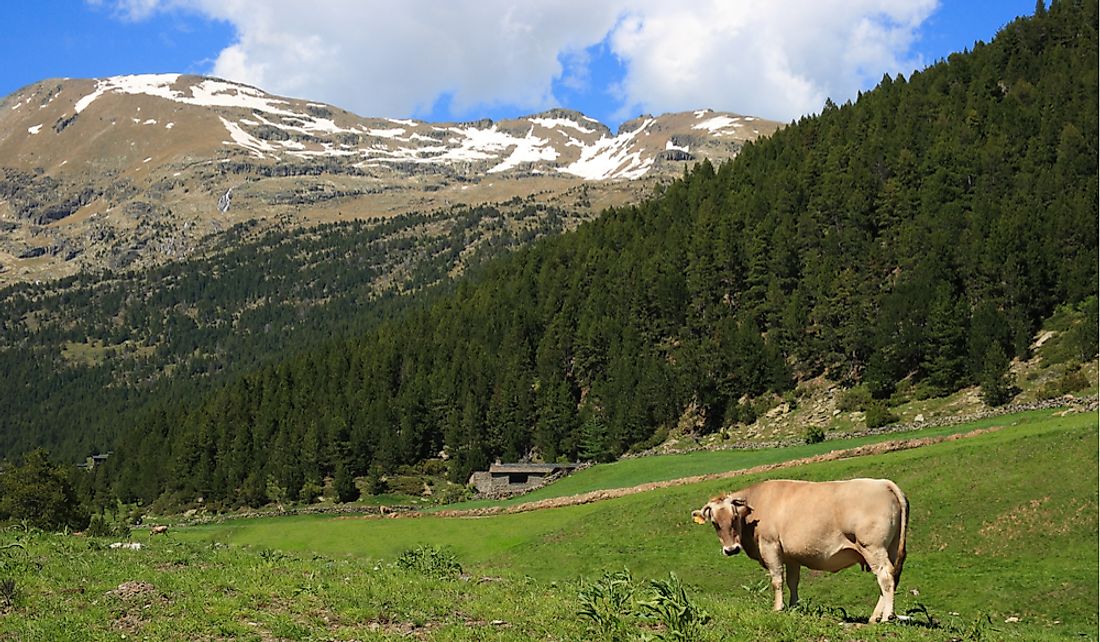What Are The Major Natural Resources Of Andorra?

Andorra is a landlocked nation located in Western Europe. As it covers an area of only 181 square miles, the nation is considered a microstate. However, despite its small area, Andorra's economy is considered to be well developed. In 2016, the country had an estimated nominal gross domestic product of $3.25 billion, which ranks 180th globally but is ranked 26th in terms of GDP per capita. Andorra's economic prosperity is attributed to factors such as the careful use of natural resources, as well as the laws introduced to stimulate economic development. The country has a series of important natural resources, which include beautiful scenery, arable land, and minerals.
Scenic Beauty and Tourism
Andorra's most important natural resource is its beautiful scenery, which attracts a vast number of tourists to the nation. In fact, some consider Andorra to have some of the best scenery in Europe. One of the country's most beautiful sites is its capital city, Andorra la Vella. The Andorran government estimates that the city is the most frequently visited place in the country. The city is situated approximately 3,375 feet above sea level, making it one of the world's highest capital cities. Another major attraction is Casa de la Vall, which is one of the most important historical buildings in Andorra. The building was initially constructed in the late 16th century as a manor house for one of Andorra's most prominent families, the Busquets. Currently, Casa de la Vall is used as the head office of the General Council of Andorra. Another major tourist attraction is Andorra's mountains, which are considered ideal for skiing and snowboarding. Ski resorts were constructed in Andorra to take advantage of the large number of tourists in the region, the most well-known resort being Vallnord, which is located in the Pyrenees mountain range. Tourism is Andorra's most important economic sector, contributing roughly 80% of the country's gross domestic product.
Arable Land and Agriculture
The second most important natural resource in Andorra is arable land. Despite its importance to the Andorran economy, arable land only accounts for approximately 2% of the country's total area. The small amount of arable land is explained by the fact that Andorra is an extremely mountainous country. Additionally, Andorra's many mountains create a shadow effect in some areas, and therefore most land suitable for agriculture faces a southern direction. Until the country established a booming tourism industry, agriculture was Andorra's most important economic activity, and most Andorran families were involved in the sector. However, according to recent estimates, only 0.5% of the Andorran workforce is currently involved, either directly or indirectly, in the agricultural sector. There are various important crops grown in Andorra, the most prominent being tobacco and barley. Several challenges affect the Andorran agriculture industry, especially a lack of modernization in the sector. In response, the Andorran government has introduced several measures to improve the country's agricultural output.
Tobacco
The most important crop grown in Andorra for much of its history has been tobacco. In fact, given its importance to the Andorran economy, some consider it to be the country's national plant. Andorran tobacco is of exceptionally high quality and is used for cigarettes and cigars. Some international tobacco companies have even established operations in Andorra in order to take advantage of the high-quality tobacco grown in the country. Most of Andorra's best tobacco is grown in the country's mountainous regions. One of the country's leading tobacco growers was the Reig family, and after closing their tobacco factory, the family converted it into a tobacco museum, which has become one of Andorra's leading tourist attractions. A significant challenge facing the Andorran tobacco industry is the constant smuggling of tobacco products across international borders. Due to policies introduced by the government, the price of tobacco products in Andorra is much cheaper than other countries, and the low tobacco prices tobacco have created potential profits for smugglers.
Livestock
Livestock is another significant natural resource in Andorra. Throughout the country's history, livestock farmers have kept sheep, cattle, and mules. In addition to Andorran livestock, the government allows livestock from other countries, such as Spain and France, to graze within Andorra's borders. A large majority of the cattle raised in Andorra are for beef production, as beef farming is most conducive to Andorra's climate. Nevertheless, Andorra's dairy sector still produces enough supply to meet or exceed the demands of the Andorran people. Excess milk produced in Andorra is sold to other nations in the European Union (EU).
Minerals
Andorra also has a significant number of minerals, such as iron and lead, which are some of its most important natural resources. Historically, Andorra's iron was extremely popular in Spain due to its high quality. Presently, Andorra has substantial deposits of iron ore which are situated in the Ordino Valley. Many mineral deposits in the Ordino Valley are extremely difficult to exploit and have remained untouched since their discovery.
Challenges Facing the Andorran Economy
The Andorran economy has faced certain challenges that have caused its gross domestic product to decline significantly from its highest levels in 2008. For example, Andorra has been significantly impacted by climate change, which has reduced the amount of snow on its mountains, reducing the number of tourists in some regions of the country. Given its importance in the Andorran economy, a decrease in tourism is significant.











